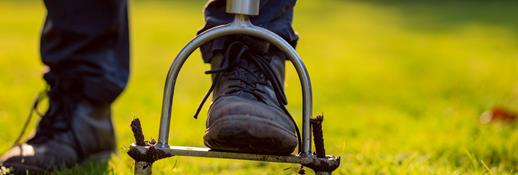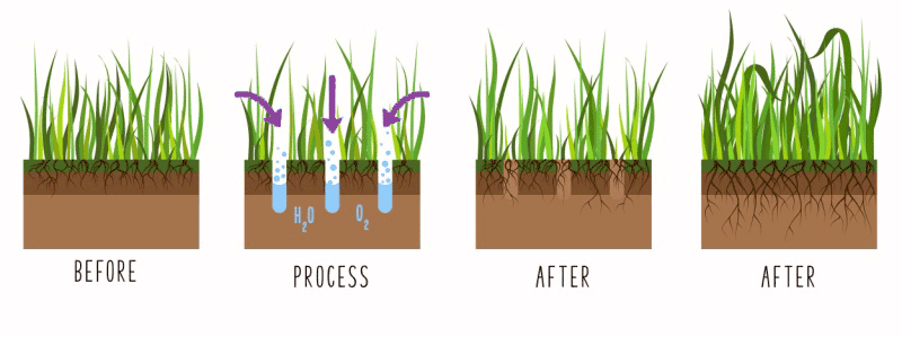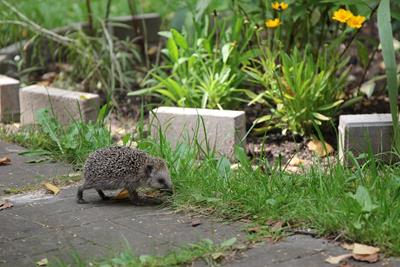
Do you envy the lush, green turf of Wembley or the manicured splendour of a National Trust garden? Even if you're not an expert gardener, you can improve your chances of a healthy, thriving grass plot by knowing how to aerate a lawn.
Check out our step-by-step guide on lawn aeration to find out how, when, and what you need to do for strong roots and a lush, beautiful lawn.
EASY AS HACK
You’ll find that core or plug aeration works better on clay and compacted soil compared to spike aeration.
At a Glance
The signs you need to aerate your lawn are:
- soil compaction
- brown patches
- dead layers of grass and debris, or ‘thatch’
- developing moss
what is lawN aeration?
Aerating your lawn helps break up compacted soil, which happens when the ground gets too packed down, due to poor drainage or just people walking on it [1]
tools needed when aerating your lawn
Selecting the appropriate tools that match the size of your garden is crucial for effectively aerating your lawn. Here are the different types of lawn aerators to help you find the best for your needs:
-
Lawn aerator shoes
Spiked shoes with attachments that create holes as you walk.
Ideal for: Tiny lawns and gardens, and low budgets.[2]
Not suited for: Clay or heavily compacted soil. -
Electric aerator
Corded, cordless or petrol-powered aerators similar to a lawnmower with blades rather than spikes.
Ideal for: Medium-large lawns with moss and thatch.[3]
Not suited for: Anyone without the space to store it. -
Manual aerator
Hand-held garden fork or aerator with hollow or solid prongs/tines on a drum.
Ideal for: Clay, thatched and mildly compacted lawns.
Not suited for: Highly compacted gardens or heavy clay. -
Spike aerator
Spikes or prongs on a roller that you push or pull along.
Ideal for: Lightly compacted small to medium-sized and sandy lawns.
Not suited for: Anyone without the strength to walk or push.[4] -
Liquid aeration
Conditioner for the soil that breaks it up so it’s less compacted and improves drainage.[5]
Ideal for: Lawns with poorly conditioned soil that’s too hard to aerate physically.[6]
Not suited for: Replacing core aeration or heavily compacted lawns.

how to aerate your lawn
Follow our step-by-step guide on how to aerate your lawn and what to be aware of before starting.
1. timing
Make sure to choose a suitable time to aerate your lawn. Ideally, you should try doing it once or twice a year in the spring or autumn when the grass is growing.
You’ll find the task easier if you wait one or two days after rain before aerating your lawn.
2. prepare your tools
Choose an aerating method (core or spike aeration) and decide on the tool to use. Your decision may come down to the size of your garden, how fit you are, and what goals you have in mind.
Spike aerators are useful for gentle aeration, while core or hollow-tine aerators remove soil plugs and work effectively on severely compacted, thatch-affected lawns and clay soil.[7] While machine based slit aeration is effective, it doesn’t penetrate as deeply as spikes and tines do, which is why it’s particularly suitable for heavy clay soils.
3. aerate your lawn
If you are using a garden fork or manual spike aerator, you must cover all your grass with holes, ideally 5 inches deep and leave a six-inch gap.
- Work across or down in your garden in straight lines, similar to when you are mowing the lawn, and overlap each pass[4]
- You don’t have to aerate the whole garden in one go, you can divide it up into sections and work at one area at a time
- Use the correct aerator for the soil
- core for heavily compacted and clay soils
- spike for moderately compacted soil
- liquid for mild-moderate aeration, thick thatch and waterlogged gardens [8]
4. maintain
Once you have aerated your lawn, be sure to water it well, so the soil can soak up all that moisture.
You should aerate your lawn one or twice a year to maintain a healthy lawn.
why you need to aerate your lawn
You should aerate your lawn to reduce compaction from walking on it and natural settling.[9] Aerating will boost its health and help it reach its full potential in these ways:
- Giving your turf the oxygen its roots need to thrive
- Allowing air, water and nutrients to reach the roots
- Promoting better growth by reducing thatch[8]
‘Thatch’ is the layer of dead, non-decayed organic matter in lawns that lies between the soil surface and the green shoots or stems.
when is the best time to aerate your lawn
The best time to aerate your lawn is in the spring or autumn, because the soil is usually moist, which makes it easier to poke holes into it one to three times a year. Most people prefer to do it in spring
how to tell if your lawn needs aerating
You’ll notice a few signs that your lawn could use some aerating. Here’s how to tell when your lawn needs aerating:
- Soil compaction – If your lawn is hard underfoot and cracked, or it’s challenging to insert any gardening tools
- If your lawn looks brown and thin after you’ve mowed it, it could indicate excessive thatch build-up [9] or brown patch fungus[4]
- There’s a poor water drainage problem, like those puddles that stick around during a rainstorm.
Your lawn will continue to thrive. Protect it from damage and your tools from theft.
Learn about garden cover and find out more about our Ageas Home Insurance.
FAQs
What is the difference between core aeration and spike aeration?
The difference between core aeration and spike aeration:
- Core aeration is a long-term fix that creates small soil plugs that help reduce compaction, but the holes it leaves are visible and must be left to decompose.
- Spike aeration is a short-term, quick fix that involves poking holes into a mildly compacted lawn.[4]It moves the soil to the side but doesn’t reach as far as core aeration and may be less effective on heavy, severely compacted turf.
Do you have to aerate a new lawn?
You do not have to aerate a new lawn after sowing or laying. However, you should wait for around six months, so the lawn has time to root[4]before aerating.
What tools do you need to aerate a lawn?
The tools you need to aerate a lawn include a simple garden fork that you may already have, manual and powered aerators depending on the size of your lawn, and liquid aerators, which act as a condition for the grass.
What are the different lawn aeration methods?
The different lawn aeration methods are core aeration for long-term use on heavily compacted lawns, and spike aeration – a temporary solution for mildly compacted turf. Liquid aeration is best for lawns where it’s challenging to use mechanical or manual aerators.
Sources
[2] Gardenwarehousedirect.co.uk
[4] lawnlove.com


